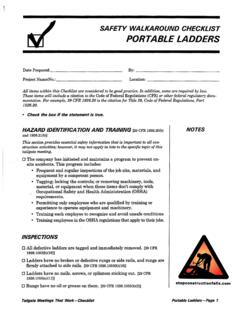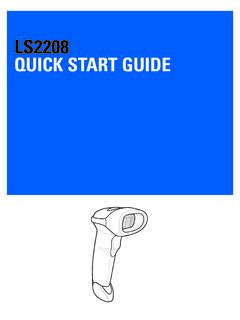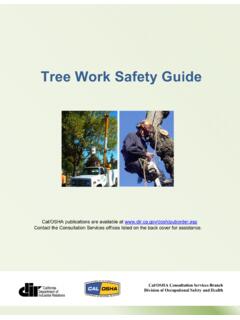Transcription of FALL PROTECTION PLAN - Stop Construction Falls
1 PLAN. PROVIDE. TRAIN. Three simple steps to preventing Falls . Company Name: _____ Date: _____ Job Name: _____ Jobsite Phone: _____ Job Address: _____ Job Foreman: _____ Qualified Person: _____ 1. JOBSITE/BUILDING DETAILS Use the following page to sketch and note the important details of the jobsite. Be sure to consider: Type of jobsite or building ( two-story residential home, commercial high-rise, highway work ) Type of work being done ( framing, roofing, electrical, restoration) Prevention through Design measures already in place ( permanent railings or permanent ladders) Relevant work surfaces & building materials ( abrasive concrete edges, slippery floors) Estimated duration of job (should you consider longer-term solutions such as scaffolding vs. moveable lifts?) FALL PROTECTION PLAN CPWR The Center for Construction Research and Training created this document as part of the National Campaign to Prevent Falls in Construction to provide companies with guidance on how to develop or enhance their site-specific fall PROTECTION plans.
2 While OSHA only requires a written fall PROTECTION plan for employees engaged in leading edge work , precast concrete erection work , or residential Construction work who can demonstrate that it is infeasible or it creates a greater hazard to use conventional fall PROTECTION equipment (See (b)(2), (b)(12), and (b)(13)), CPWR believes that developing and implementing a detailed fall PROTECTION plan is essential to protect all workers at risk for a fall. We encourage you to use any and all sections that are applicable to your jobsite(s). Note: blue text indicates that a word can be found in the glossary at the end of this packet. For more information about the National Campaign to Prevent Falls in Construction , including how to participate in the annual Safety Stand-Down, visit PLAN. PROVIDE. TRAIN. Three simple steps to preventing Falls . JOBSITE/BUILDING DETAILS Use this space to sketch and note the important details of the jobsite.
3 PLAN. PROVIDE. TRAIN. Three simple steps to preventing Falls . 2. FALL HAZARDS IN THE work AREA In the Construction sector OSHA requires fall PROTECTION for workers at heights of 6 or more above the ground or a lower level, but slips, trips, and Falls can occur at any height . In order to make this plan comprehensive and useful to everyone interested in providing a safer work environment for their employees, we have included these hazards as well. Check all that apply. Add others in the empty rows if necessary. Include locations and dimensions next to each hazard, and/or note these hazards on your drawing above. Hazard Location Dimensions/Details Open-sided walking/working surfaces ( roofs, open-sided floors) Open-sided ramps, runways, platforms Leading Edge(s) Floor openings Wall or window openings Skylight openings Elevator shaft Stairwell Trenches Uneven surfaces or surfaces that do not meet the definition of a walking/working surface Other: 3.
4 ACCESS EQUIPMENT BEING USED This section provides space to identify the access equipment that will be used to allow workers to reach the heights necessary to conduct work (fall arrest, fall restraint, and fall PROTECTION equipment is covered in section 4). When selecting access equipment, it is important to use the right equipment for the work being performed. You may also want to consider how access equipment may be used for rescue in the event of a fall (see section 8). Add other equipment to the empty rows if necessary. Access Equipment Location Dimensions/Details Load Capacity Scaffolding Mast Climbing Scaffold(s) Aerial Lift(s) Scissor Lift(s) Boom Lift(s) Push Around Vertical/ Vehicle Extension Ladder(s) Step Ladder (s) Fixed Ladder (s) Other: PLAN. PROVIDE. TRAIN. Three simple steps to preventing Falls . Limitations to Access Equipment: Each type of equipment has different advantages and disadvantages.
5 For example, while ladders may provide quick and easy access, there is a high rate of injury just from climbing up and down, and in some cases a scaffold or lift may be safer. A competent person should carefully review all existing fall hazards and work activities, along with safe use requirements and product limitations, to ensure the best equipment is selected. List any possible limitations to the equipment you ve selected and steps to address them below: Access Equipment Limitation(s) Steps to Address Limitation(s) Assembly, Maintenance, Inspection, Disassembly Procedures: Assembly and disassembly of all access equipment should be done according to manufacturers recommendations. Copies of manufacturer s specifications should be included in your plan for each type of equipment used. Pre-job checks should be conducted daily. Any defective equipment should be tagged and removed from use immediately.
6 Manufacturer recommendations for maintenance and inspection should be followed. Use the following table to describe procedures for assembly, maintenance, inspection, and disassembly of access equipment to be used. Be sure to note the name of the qualified person responsible. Access Equipment Assembly & Disassembly Maintenance & Inspection Qualified Person 4. METHOD OF FALL ARREST OR FALL RESTRAINT When selecting appropriate personal fall arrest or fall restraint systems, refer back to the sections above to consider factors such as building material, height of work , and specific hazards such as leading edges. Fall arrest systems work by stopping a free fall after the fall occurs. Fall restraint systems work by preventing the fall from happening after a slip or trip. It is important not only to select the appropriate systems, but to ensure that the category of equipment and materials used to construct each piece in the system are sufficient to mitigate the hazards.
7 It is also important to consider the fall clearance distance needed for both height and swing clearance (see infographic below; actual totals will be based on the characteristics of each worker and the equipment selected). Check all that apply. Add other methods in blank rows if necessary. Write details such as manufacturer or location of anchorage points next to equipment when relevant. PLAN. PROVIDE. TRAIN. Three simple steps to preventing Falls . Method of Fall Arrest or Restraint Load Capacity Other Details Full Body Harness Body Belt Positioning Lanyard Self-Retracting Lifeline (SRL) Lifeline Travel Restraint Line Horizontal Lifeline Rope Grab Deceleration Device Shock Absorbing Lanyard Locking Snap Hooks Safety Nets Guard Rails Warning Lines Safety Monitor Name of Monitor if used: Toeboards Slideguards Other: PLAN.
8 PROVIDE. TRAIN. Three simple steps to preventing Falls . Limitations to Fall Arrest/Restraint Equipment: Are there any potential limitations to the system(s) selected? For example, if the length of a lanyard constantly needs to be adjusted, you may determine that an SRL is the better choice. A competent person should carefully review all existing fall hazards and work activities, along with safe use requirements and product limitations, to ensure that the best fall PROTECTION system is selected. List any potential limitations and steps to address them here: Fall Arrest/Restraint Equipment Limitation(s) Steps to Address Limitation(s) Assembly, Maintenance, Inspection, Disassembly Procedures: Assembly and disassembly of all fall arrest/restraint equipment should be done according to manufacturers recommendations. Copies of manufacturer s specifications should be included in your plan for each type of equipment used.
9 OSHA states that personal fall arrest systems shall be inspected prior to each use for wear, damage and other deterioration. Any defective equipment or components should be tagged and removed from service immediately. Manufacturer recommendations for maintenance and inspection should be followed. A generic fall PROTECTION equipment inspection checklist can be accessed at Use the following table to escribe procedures for assembly, maintenance, inspection, and disassembly of fall PROTECTION systems to be used. Be sure to note the name of the qualified person responsible. Fall Arrest/Restraint Equipment Assembly & Disassembly Maintenance & Inspection Qualified Person 5. OTHER MITIGATION OF FALL HAZARDS Depending on the fall hazards you checked in Section 2, additional safety measures may be needed. For example: installing substantial covers over skylights, posting signs alerting workers to floor openings or other dangers, or instituting good housekeeping measures to keep floors and work surfaces clean and clear of debris that could contribute to slips and trips.
10 Describe additional fall hazard mitigation plans here and/or mark them on your drawing: _____ _____ PLAN. PROVIDE. TRAIN. Three simple steps to preventing Falls . 6. PROTECTION OF NEARBY WORKERS Handling, Storage, & Securing of Tools and Material Steps should be taken to prevent tools and materials being used at heights from falling to lower levels. Toeboards or slideguards can be installed on roofs and scaffolding at a height that will prevent tools from sliding over the edge or down the slope. Lanyards may be used to avoid dropped tools. Describe plans for handling, storage and securing: _____ Overhead PROTECTION Hardhats are required on all jobsites with the exception of those that have no exposure to overhead hazards. Warning signs should be posted to caution of overhead hazards whenever present. Conditions may warrant additional PROTECTION , such as the use of debris nets.






